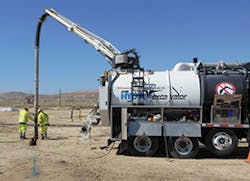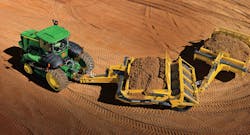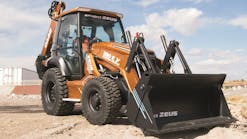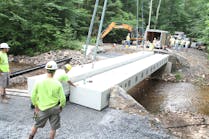There are three ways to dig a hole, points out Brian Metcalf, CEO of Ring-O-Matic.
“You can dig it by hand, you can dig it with a mechanical method, or you can utilize vacuum excavation,” he says. “Vacuum excavation obviously is significantly safer and is a completely different approach to digging a hole as opposed to using an excavator to do so.”
Vacuum excavation uses either water or air. When water is used, it’s called hydro excavation.
Vacuum excavators, especially hydro excavators, may be the most versatile piece of equipment in a contractor’s fleet, notes Ben Schmitt, Vactor Mfg.’s product manager.
Hydro or air vacuum excavation offers a number of advantages to contractors, not the least of which is a safety value proposition when locating and digging around underground utilities, says Schmitt.
This safety aspect gives contractors a competitive edge, lowers insurance costs, and reduces job-site downtime.
The precision of hydro and vacuum excavation also lowers the cost to return the site to its original condition because the overall size of the excavation can be minimized, points out Schmitt.
Contractors appreciate the versatility of the equipment, he adds.
“Over the past five years, we’ve seen a significant gain in acceptance of vacuum excavation throughout the United States,” says Schmitt. “Contractors are targeting larger, more productive truck-mounted vacuum excavation units for increased productivity and flexibility. Hydro excavation also appears to be the lion’s share of the market for its versatility and productivity.”
Some utility companies, transportation departments, or power plants specify air vacuum excavation for a given job for a number of reasons, says Schmitt. “Air vacuum excavation is desired in applications where the soil tends to be loose, water is not readily available—in small-scale excavation projects—or where immediate backfill of the hole is required. When working around buried electrical lines or brittle utilities, air vacuum excavation is often preferred due to the lower operating pressures.”
While the utility segment appears to be somewhere around 20% of the total vacuum excavation market, there has been a substantial shift to the oil and gas production sector, where demand continues to increase, notes Schmitt.
In the oil field market sector, contractors have used the Vactor HXX, a hydro excavator, not only to daylight utilities, but also to clean the inside of mud or storage tanks, clean up oil spills at job sites, and perform various cleanup applications after the drilling process is completed, says Schmitt.
Other applications for utilities, construction, and municipalities include installing light poles, repairing water main breaks, long trenches for burying cable, fiber optic repair, cathodic protection for gas and water lines, pressure testing, hauling fresh water to a job site, towing a trailer, and even window well installation, he adds.
“Hydro excavators, like the Vactor HXX, are designed for safer, non-destructive location of buried utilities,” he notes. “This application is often called daylighting or potholing.”
The equipment can do much more, adds Schmitt.
“A hydro excavator consists of a powerful vacuum system and an onboard water blaster and water tank, so anything that can be sprayed, washed down, or vacuumed can be completed with this equipment,” he points out.
When exploring vacuum excavation system choices, the decision between an air or hydro unit is an important one, points out Schmitt, adding that both mediums have “very distinct advantages.
“Air vacuum excavators use compressed air to loosen the soil and positive displacement blowers to vacuum the spoils into a tank. Hydro excavation uses high-pressure water to loosen soils, and the residual slurry spoils are easily extracted into the debris tank via positive displacement blower or centrifugal compressors,” says Schmitt. “Air excavation is slower, but allows for dry material to be immediately backfilled into the hole and eliminates the need to find disposal locations, while hydro excavation is much faster and versatile, but requires clean fill to be brought in.”
The key to efficient hydro excavation is to only use enough water to cut the soil effectively, says Schmitt.
“All too often, operators use more water than is required and spend more time offloading material,” he adds. “Using the proper amount of water for the job will maximize the operator’s efficiency and maximize productivity.”
Jeff Wage, vice president of McLaughlin, says the biggest use of hydro excavation that he sees among grading and excavation contractors is “getting out in front of their open cut operations to spot utilities or dig around high risk or anything that may divert their productivity of the project.”
The technology replaces the need for an individual to get down in a hole with a shovel looking to expose a 12-inch water main as he or she gets direction to take one more scoop with the bucket, says Wage.
Instead, the hydro excavator enables contractors to locate the water main and expose it as the excavation project either crosses or intersects it or parallels the line, he adds.
“They’ve safely dug around it and exposed it, so when they get into an excavation operation, they can do what they’re good at, which is stay productive, move dirt, and lay pipe,” says Wage.
Hydro excavation is indicated for digging around not only water mains, but sensitive utilities such as fiber optics, electrical boxes, and gas lines “where you’re not quite sure where the utility is and you don’t want to use mechanical excavation,” notes Wage, echoing that safety is a primary benefit.
“As you’re excavating, the ability to dig around a line and not damage it is safety for the people on the job site as well as property owners and third-party utilities,” he notes. “You wouldn’t want to mechanically damage that, have an explosion, harm the operator, and damage equipment on the job site.”
Another safety consideration comes into play when avoiding damaging a utility and creating a leak, says Wage.
“There are long-term risks in safety implications of back feeding a sewer system with some natural gas and creating a large explosion,” he says. “There are a lot of risks in damaging or creating a small leak on gas and having that seep into another utility, mainly a sewer system.”
Whether to use water or air excavation “is the great debate and the question everyone asks,” notes Wage. “Hydro excavation really helps you when you’re digging in any of the colder climates because you can dig and cut in frost and do that excavation in cold weather. Hydro excavation typically is 75% more productive than air in most soils because it will cut and erode the soil more rapidly.
“People who want to use air want the ability to pick up and reuse material on the same job site without having to haul it off and bring in other material.”
Air-based excavation is useful in working around granular soils and sand, such as is found in coastal areas, says Wage.








